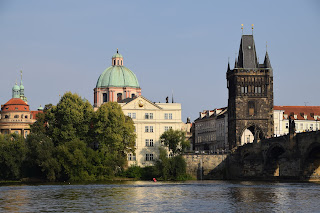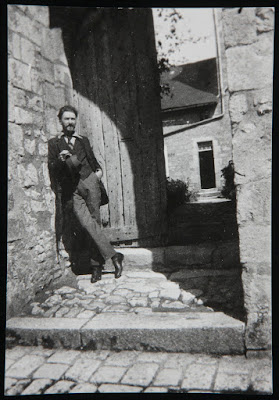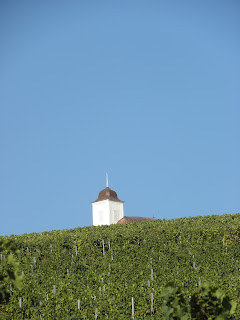Prague Revisited
The article that follows was published by Hungarian Review in two parts. Part 1 was published in its November 2018 issue and Part 2 in January 2019.
Four hundred years ago, on 23
May 1618, three men were thrown from a window in Prague Castle Old Royal
Palace
Historians have taken the 1618
Defenestration of Prague as marking the beginning of the Thirty Years' War, a
conflict that raged ferociously, mostly across Bohemia
and other parts of the Holy Roman Empire , from
1618 to 1648, drawing in the armies of most of the European powers of the time.
It was the most murderous war that Europe had
known, and the Thirty Years' War continued to hold that dubious honour until
the even more deadly wars of the twentieth century.
The centrepiece of the Old Royal Palace in Prague
Castle
In the 1618
Defenestration of Prague representatives of the Protestant-dominated Bohemian Estates threw the Imperial governors
from the window on the left.
The 1618 Defenestration is not
the only anniversary being marked in Prague
- Czechoslovakia Czechoslovak
Republic Prague Royal Court
-
Eighty years ago, in 1938, the notorious Munich
-
Seventy years ago, February 1948 ("Victorious February" to the
Communists) marked the beginning of Communist rule that was to last for nearly
42 years in Czechoslovakia Prague Prague
1948
painting by Eduard Stavinoha in the Veletržní
Palace Czechoslovakia
- Fifty
years ago, 1968 brought the Prague Spring, the softening of harsh Communist
rule under the leadership of Alexander Dubček, followed by the Soviet invasion
on 21 August 1968 that brought the experiment of "socialism with a human
face" to an end. Anniversary graffiti that appeared on the walls read
"1938 - 1968". On 21 August 2018 a concert was held in Wenceslas Square Prague Bohemia Prague
Photograph
by Josef Koudelka in a 50-year anniversary exhibition of his 1968 photographs.
The Russian soldiers had been told they were going into Czechoslovakia as liberators and were totally
unprepared for the passive resistance they met on the streets of Prague
***
I am just old enough remember the
politics of 1968, and to have taken an active interest in them at the time. An outdoor exhibition in Jungmannovo Square this past summer
of photographs taken by a young American (Paul Goldsmith), who happened to be
passing through Prague on 21 August 1968, and an indoor exhibition of photos by
Josef Koudelka at the Veletržní Palace in Holešovice, brought back memories of
those black-and-white days, not just of what the newspapers told us was
happening in Prague but of that entire heady year. To a wide-eyed teenager, it
seemed that during 1968 the world revolved around three places - Berkeley (named, incidentally, for an Irish bishop in
whose philosophy nothing really existed), Paris
and Prague
By the autumn of the year,
however, reality -"normalisation" as it came to be called in Prague France Czechoslovakia ,
137 people died as the Soviet-led invasion occupied the country with tanks and
soldiers to impose Moscow Russia Wenceslas
Square
Although it was all over,
Peter Huber (later a Senior Fellow of the Manhattan Institute) and I decided to
go to Prague Budapest
Over the following years I
looked across the border into Czechoslovakia
- across the Danube from Esztergom, through the trees of the Böhmerwald in Bavaria Toronto Toronto then was a publishing house, founded and run by
Josef Škvorecký, for Czech and Slovak books that would not pass the censors in Prague
A photograph
I took in 1990 of the towers at the Malá Strana end of the Charles Bridge
But it was only 21 years after
my visa was refused, in the early weeks of 1990, that I actually made it to Prague Charles Bridge
Over the following few years, Prague Wenceslas Square Royal Route Charles
Bridge Wenceslas Square Old Town
Zlatá ulička
(Golden Lane
***
The Czechs are the farthest
west of Europe 's Slavic-language speakers. As
the medieval German Ostsiedlung advanced,
the Czech-speaking population came to be surrounded on three sides by Germans
and an integral part of the German-dominated Holy Roman
Empire , of which the King of Bohemia became one of the seven
electors. The greatest king of the of the native Czech Přemyslid dynasty was
Ottakar II who reigned from 1253 to 1278. Yet, he does not feature prominently
in the canon of Czech historical imagination, possibly because he invited
German-speaking trades people to settle at the foot of the Castle in Prague


A map (in
Polish) showing the eastward expansion of Germans (Ostsiedlung) during the Middle Ages.[1]
In 1938, Hitler called the Czechs a "Slav bulwark against the Drang nach Osten."
The Přemyslid dynasty gave way
to the Luxembourgs Bohemia to be accorded a place of honour in the otherwise
rather populist historical consciousness of Prague Prague
over the many other cities of his Empire (though he also had a soft spot for Lucca Prague
The Gothic
St Wenceslas Chapel in St Vitus Cathedral, built by the architect Peter Parler
in the reign of Charles IV in memory of one of Bohemia's early Czech rulers.
To Charles IV Prague owes many
of its most famous monuments. In 1344, under pressure from Charles, the Pope
raised Prague , hitherto a bishopric dependent on
Mainz Cologne
Peter Parler was also
responsible for the Gothic bridge over the Vltava
that has borne Charles' name since 1870. In 1348 Charles founded the Prague Old Town
There arose at this time too a
current of social and political discontent, in large part directed against the
Church which was seen as unacceptably wealthy, morally corrupt and distant from
the original principles of Christianity. The Great Schism of 1378, following
which there were two Popes, one in Rome and one
in Avignon Prague
Bethlehem Chapel developed
close links with the reformist "Bohemian nation" of Charles University ,
and in 1402 Jan Hus, one of the University's masters and later its Rector
(1409-10), was appointed preacher at Bethlehem Oxford
Theologically, Hus does not
seem to have been a thoroughgoing Wycliffite. He believed in Christ as the true
head of the Church, in the return to poverty and early church values, and in
Scripture as the sole basis for Church life; but he did not follow Wyclif in
rejecting transubstantiation. Nor did he practise giving communion in both
kinds (sub utraque specie), the
practice that gave rise to the movement's name ("Utraquist") and to
the chalice as its symbol - the symbol of the equality of all Christians before
God. That first happened in late 1414, when Hus was already in prison in
Constance, at the little Church of St Martin in the Wall, under the direction
of Hus's colleague Jakoubek of Stříbo.
Hus' break with the Catholic Bohemian
establishment came gradually, but by 1412 it was complete. One Pope, to raise
money to fight his rival, launched the sale of indulgences. Jan Hus and others
in Prague Prague
The Council of Constance was
called in 1415 chiefly to resolve the scandal of the, by-now-threefold, Papal
schism, but Jan Hus (and the teaching of the heretic John Wyclif) was on the
agenda. Hus travelled to Constance under a
safe-conduct pass from the Emperor, to defend his ideas. But there he was
imprisoned, refused to recant his views, and was burnt at the stake as a
Wycliffite heretic on 6 July 1415.
The
monument to Jan Hus in Prague Old Town Square
Hus's execution caused outrage
in Bohemia, and over the following years, the Hussite armies, singing hymns, flying
the banner of the chalice and under the military genius Jan Žižka, defied and
defeated successive waves of Catholic armies sent in to bring the heretics of the
Czech lands back into the fold of European political correctness as it was then
defined. The last of the many failed Crusades against Bohemia Prague
Following the 1436 Compact of
Basel the Catholic Church tolerated moderate Utraquists celebrating communion
in both kinds, but things began to change again in the early years of the 16th
century. Lutheran ideas seeped into the country. While the Hussite movement,
both Utraquist and Radical, had largely been among the Czech-speaking
population, Luther's reformation appealed also to Bohemia Bohemia Vienna from Prague Hungary
Theoretically, the Crown of
Bohemia, like that of Hungary Scotland
and I of England
***
We took tram no. 22 to its
terminus on the height of ground to the west of Prague
The farm
track that leads to the simple cairn erected in 1920 to mark 300 years since
the Battle of White Mountain
The Battle of White Mountain
marked the end of the opening, "Bohemian", phase of the Thirty Years'
War. The re-imposition of Habsburg rule and of Catholicism was swift. 27
prominent Protestants were executed in New Town Square Bohemia
was in effect a province of Austria , administered from Vienna
Memorial on
Charles Bridge
to mark the spot where John of Nepomuk was thrown into the Vltava .
The metal work is kept polished by the pious touch of passers-by.
By the terminus of the No. 22
tram at Bílá Hora there is Baroque church surrounded by dusky yellow walls.
This is the early-eighteenth-century church
of Our Lady church of Our Lady
of Victory at Bílá Hora has never been open when I have been there, but its name,
its location on battle site and pilgrimage route, and the style of its
architecture remind one that Baroque is the artistic expression of the Counter-Reformation
in Prague St John
of Nepomuk, line up on the parapets of Charles Bridge
The church of Our Lady Prague during the
re-Catholicising of Bohemia
***
The awakening of Czech
nationalism - Czech National Revival - began in the late 18th century and
developed apace through the nineteenth and into the twentieth centuries. In
keeping with the Romantic spirit of the times, the fervour was ethnically based
rather than based on the old multi-cultural (Czech, German, Jewish) territory
of the Kingdom of
Bohemia
The severe structure of the
country's National Monument (where Klement Gottwald's embalmed corpse was
housed in Communist times) sits on Vítkov Hill where Žižka won the most famous
of his battles. An enormous equestrian statue of Žižka stands there overlooking
Prague Prague
A rare
surviving street sign in German and Czech. Until 1893 Prague street Prague
Jan Hus himself stands in the
very heart of Prague Old Town Square Bohemia Constance
in 1415.
The
standard of the President of the Czech
Republic
St Jan Nepomucký, on the other
hand was falling from grace: "by the end of the nineteenth [century], he
had become an unwelcome interloper, at least in nationalist eyes"[2],
"a saint fabricated by the Vatican in the eighteenth century in the
interests of erasing the memory of Hus and Žižka".[3]
In 1969, the Vatican
The secular memorials of the
three-hundred years Austrian domination were not left untouched either. Field
Marshall Radecký was a Bohemian nobleman who had risen to become chief of the
Austrian General Staff and who was celebrated by Johann Strauss in the Radetsky
March. His statue that stood in Malostranské
Square
The
Czech National Revival has left its mark on the patriotic architecture of the town.
The Municipal House where a former royal place had once stood, the National Museum
at the top of Wenceslas Square Vltava
date from this time. The cathedral of St Vitus, left unfinished since Hussite
times, was completed - in a style
remarkably sympathetic to the original Gothic architecture. It is more a
national monument now than a religious one. One of the windows in the newer
west end of the cathedral is by Alfons Mucha, who had made his name in Paris
The
National Theatre on the banks of the Vltava ,
built as part of the Czech National Revival, entirely with subscriptions from
private individuals, in the late 19th century.
The iconic Bethlehem Chapel
fell into the hands of the Jesuits after the Battle of White Mountain. What was
left of it was demolished in the late 18th century, when many ecclesiastical
buildings were torn down, and later a block of flats was built on its site.
Curiously, it was rebuilt under the Communists between 1948 and 1954. Jan Hus
and the Hussites had been re-imagined yet again. This time they had become
medieval proto-Communists. In 1956 Jirásek's Proti všem, starring the heroic Hussites, was made into a big-budget movie. Jan Želivský - the radical
Hussite priest who preached at the Church of St Mary of the Snows, championed
the poor, and who was later executed on the orders of the town council - was
commemorated by the Communists with a plaque on the Old Town city hall that
recognises him, in the categories of Communist history lessons, as a
"victim of the bourgeoisie". In twenty-first century internet
chatter, Hus, Želivský, Žižka and their comrades have metamorphosed into early
human-rights campaigners.
***
The no. 22 tram on its way
back from Bílá Hora to the centre of Prague Bohemia
The theme of exile is picked
up in one of the twenty massive tableaux in Alfons Mucha's "Slav Epic".
Painted over many years after Mucha returned to Prague
from Paris , the "Slav Epic" went on display
at Prague 's Municipal House this summer after
its return from exhibition in Japan Netherlands Czechoslovakia Prague US
***
And what of those thrown out
of the Castle window in 1618? They survived, though probably not by landing on
the apocryphal pile of dung beneath the window. In the nearby Lobkowicz Palace
(Incidentally, Princess
Polyxena's Spanish mother gave her as a wedding present the wood-and-wax statue
now known and venerated as the Infant Jesus of Prague. Polyxena in due course
passed the waxwork on to the Carmelite nuns. It is now kept, well-dressed and
in Baroque splendour, in the Church
of Our Lady Victorious
Vilém Slavata of Chlum and
Jaroslav Bořita of Martinice left Prague Prague
The
Belvedere was built for Ferdinand I's wife, Queen Anna, in the mid 16th century,
importing the Italian Renaissance style to then Gothic Prague.
We walked back from the Lobkowicz Palace ,
past St Vitus' Cathedral and the Old
Royal Palace Hradčany Square Martinic Palace ,
one of Prague Prague
Jaroslav Martinic died in 1649,
a year after the 1648 Peace of Westphalia that ended the Thirty Years' War, 31 years after his defenestration that had sparked the conflict. Earlier
in the day, in the ambulatory of St Vitus' Cathedral, we had paused at the Martinic
Chapel where Jaroslav Martinic is buried. Jaroslav Martinic may not be numbered
among the nation's heroes in Czech historiography, but here, in death, he lies
among the kings and saints of Bohemia
[1] Source:
https://commons.wikimedia.org/wiki/File:Osadnictwo_niemieckie_na_wschodzie.PNG
[3] Sayer. op. cit. p.15


















Comments
Post a Comment